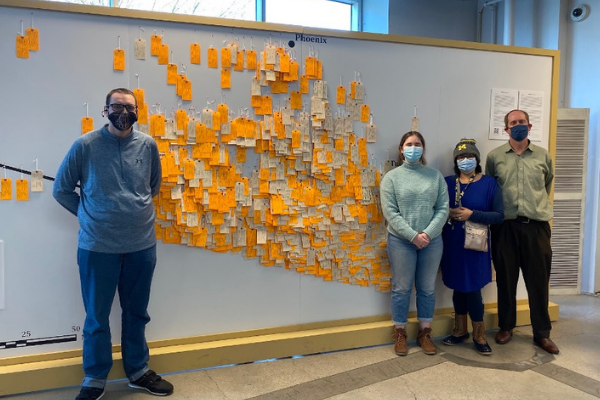Hostile Terrain 94: Documenting the Undocumented

On the border between Arizona and Mexico lies the vast Sonoran Desert, one of the most inhospitable environments in the world. In this 100,000 sq. mile desert, thousands of migrants have died and hundreds of thousands have been detained and deported. Most of these migrants go unnoticed by society. Some remain unidentified even after death. Jason De León, a former professor at the University of Michigan who is now teaching at UCLA, has created a platform to bring this reality to public attention.
Hostile Terrain 94 is currently on display at the Flint Farmers' Market. It is a participatory piece of work that displays toe tags of people who have died in the Sonoran Desert, pinpointed on the exact latitude and longitude where their remains were found. There are two different colors of toe tags on the map — manilla means that the person's remains were identified, while orange signifies that the remains are unidentified.
Plans to showcase this exhibit started when de León visited campus in 2018 to talk about his ethnographic research at the southern border. Plans were delayed due to COVID, but a group of volunteers came together to feature this project, including the Center for Global Engagement; the International Center of Greater Flint; Latinos United for Advancement; the Latinx Technology and Community Center; student, staff, and faculty volunteers at Mott Community College; and the UM-Flint Anthropology Club.
De León, the creator of this work, organized the project with the help of the Undocumented Migration Project (UMP), of which he is the executive director. The UMP raises global awareness about the border crisis through anthropology and ethnography. De León wants us to see these migrants as real people, not just statistics. Assistant Professor of Anthropology at UM-Flint Daniel Birchok says, "part of the exhibit is to put names to people, we're not just thinking about undocumented folks in the abstract."
In curating this work, De León is highlighting the US border policy of "Prevention through Deterrence," in which the U.S. guards urban areas more closely while avoiding more severe terrain such as the Sonoran Desert. The policy assumes that if migrants have to cross through an unforgiving desert to get to the U.S., they will be less likely to attempt the crossing.
Birchok puts this policy into an anthropological lens: "This exhibit helps us to see that [the U.S.] may think we're absolved of responsibility because it appears to be death by natural causes, but it's a policy choice." People didn't start dying in such large numbers in the Sonoran Desert until the policy was changed.
"In anthropology, we recognize that the distinctions between the natural and the social are always arbitrary because humans are always both natural and social beings. That makes what's happening at the border a human thing in addition to being a natural thing, you can't separate the two," says Birchok.
With this project, De León wants to "document the undocumented." Giving a platform to those whose stories go unnoticed is what the Undocumented Migration Project was created for, and Hostile Terrain 94 allows these stories to be spread all over the world. The University of Michigan-Flint, along with other community members, helped bring this project to fruition at the Farmers' Market and spread the message of humanity and compassion.
Hostile Terrain 94 is on exhibit through Saturday, November 27, at 5:00 p.m. at the Flint Farmers' Market.
Related Posts
No related photos.
UM-Flint News
The Office of Marketing & Communications can be reached at [email protected].